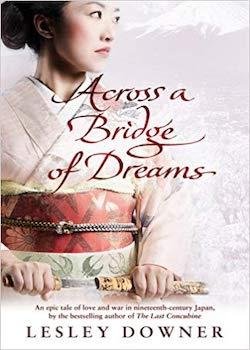Across A Bridge of Dreams

By Lesley Downer
Bantam Press
2012, 448 pages
ISBN-13: 978-0593066829
Review by Christopher Searle
I found it impossible not to compare Across A Bridge of Dreamswith Lian Hearn’s 2011 novel Blossoms and Shadows – also an epic tale of forbidden love at the time of the collapse of the Tokugawa shogunate [reviewed in issue 39 – June 2012]. While Hearn’s book spans roughly 1857 to 1867, Downer’s is set in the aftermath of the shogunate. It opens in 1873, five years after the 1868 Meiji Restoration, which instituted the emperor as figurehead and substituted the shogunate with a new form of government.
Across A Bridge of Dreams centres on the story of Saigo Takamori, one of the most romanticised and pivotall samurai of the 19th century, who also provided a model for ‘The Last Samurai’ in the 2003 film featuring Ken Watanabe and Tom Cruise.
With the demise of the shogunate in 1868, the new government was largely formed of men from Satsuma (present-day Kagoshima in southern Japan) and Choshu (present-day Yamaguchi). Many were samurai, representatives of the old elite, who ended up helping to legislate their own class out of existence, much to the disillusionment of the southern samurai.
The contradictions of the revolution were enfleshed in the person of Saigo Takamori, the basis of Downer’s character, General Kitaoka.
As the book opens, Taka, General Kitaoka’s youngest daughter with his mistress, is 13 years old. General Kitaoka, a gallant and brilliant samurai from Kagoshima, has moved to Tokyo with Fujino, a larger than life geisha from Kyoto, and their children. Kitaoka is in Tokyo in order to serve in the new government. When he can no longer bear the series of reforms being enforced which are stripping the samurai of their privileges he returns to Kagoshima where he becomes a chief agitator, outspoken against government actions which are hurting the samurai.
Early on in the tale, in parallel to the political intrigue, Taka develops a fondness for Nobu, a lad from Aizu in Fukushima in northern Japan who is hired as her manservant. Nobu reciprocates these feelings but realises that Taka, the daughter of a samurai from Kagoshima is an unattainable, illicit love. Nobu is also from a samurai family, but from the Aizu clan, arch enemies of the samurai from Kagoshima who have only too recently trounced them.
Before long Taka and Nobu are torn apart. Nobu is sent packing from the Kitaoka’s Tokyo home by Taka’s brother – wary of Nobu’s evident love for her – on, inauspiciously, ‘Tanabata’ – the one day of the year, according to legend, that the separated lovers, the Weaver Princess and Cowherd are able to cross the River of Heaven and meet, if the weather is clement.
After a few intervening years during which Nobu has been recruited and trained by the Army Cadet School and Taka engaged to be married, Nobu arrives in Kagoshima in April 1877 with the Imperial Army. Their purpose is to extinguish General Kitaoka’s feisty anti-government rebellion. While Nobu’s fellow northern samurai are raring to take revenge on their old enemy in Kagoshima, he is torn because of his feelings for Taka, who is also now in Kagoshima, and her family.
The battle between the government forces and Kitaoka’s men results in a bloody five months up to September 1877. Up on Castle Hill, a brave and heroic but resigned and tragic General Kitaoka resolutely says, ‘We fought to uphold the samurai way of life and we failed. But we can still show the world how samurai die.’
While both Downer and Hearn make use of fortuitous encounters and coincidences to maintain the plot’s momentum, Downer relies on this device a little too readily, exhausting one’s capacity for suspension of disbelief. She also contrives to draw on her knowledge of geisha – by expanding on descriptions of Fujino and her milieu – and on her knowledge of Japanese-style poems, in what at times can feel a little forced.
All in all, while a well-researched and generally engaging novel, given the story’s romance and largely thanks to Kitaoka’s (or Saigo Takamori’s) entrancing and colourful life, Across A Bridge of Dreams is rather long-winded at times and not as erudite as Lian Hearn’s book. Neverthless, the descriptions of modernising Tokyo and Ginza are very atmospheric as are those of Kagoshima – the satsumas sparkling in the snow, the volcanic ash, shochu, palm trees, Sakurajima and the distinctive Kagoshima accent are all vividly evoked by Downer.
It won’t disappoint those in search of Japanese historical fiction ‘light’ or a fix of the compelling Saigo Takamori.

